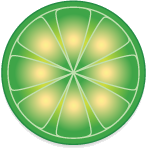Related Research Articles
In computing, an applet is any small application that performs one specific task that runs within the scope of a dedicated widget engine or a larger program, often as a plug-in. The term is frequently used to refer to a Java applet, a program written in the Java programming language that is designed to be placed on a web page. Applets are typical examples of transient and auxiliary applications that do not monopolize the user's attention. Applets are not full-featured application programs, and are intended to be easily accessible.

Java applets were small applications written in the Java programming language, or another programming language that compiles to Java bytecode, and delivered to users in the form of Java bytecode. The user launched the Java applet from a web page, and the applet was then executed within a Java virtual machine (JVM) in a process separate from the web browser itself. A Java applet could appear in a frame of the web page, a new application window, a program from Sun called appletviewer, or a stand-alone tool for testing applets.

Java is a high-level, class-based, object-oriented programming language that is designed to have as few implementation dependencies as possible. It is a general-purpose programming language intended to let programmers write once, run anywhere (WORA), meaning that compiled Java code can run on all platforms that support Java without the need to recompile. Java applications are typically compiled to bytecode that can run on any Java virtual machine (JVM) regardless of the underlying computer architecture. The syntax of Java is similar to C and C++, but has fewer low-level facilities than either of them. The Java runtime provides dynamic capabilities that are typically not available in traditional compiled languages.

A Java virtual machine (JVM) is a virtual machine that enables a computer to run Java programs as well as programs written in other languages that are also compiled to Java bytecode. The JVM is detailed by a specification that formally describes what is required in a JVM implementation. Having a specification ensures interoperability of Java programs across different implementations so that program authors using the Java Development Kit (JDK) need not worry about idiosyncrasies of the underlying hardware platform.

LimeWire was a free peer-to-peer file sharing client for Windows, macOS, Linux and Solaris. Created by Mark Gorton in 2000, it was most prominently a tool used for the download and distribution of pirated materials, particularly pirated music. In 2007, LimeWire was estimated to be installed on over one-third of all computers globally.

In mass communication, digital media is any communication media that operates in conjunction with various encoded machine-readable data formats. Digital content can be created, viewed, distributed, modified, listened to, and preserved on a digital electronic device, including digital data storage media and digital broadcasting. Digital is defined as any data represented by a series of digits, and media refers to methods of broadcasting or communicating this information. Together, digital media refers to mediums of digitized information broadcast through a screen and/or a speaker. This also includes text, audio, video, and graphics that are transmitted over the internet for viewing or listening to on the internet.
BitTorrent, also referred to as simply torrent, is a communication protocol for peer-to-peer file sharing (P2P), which enables users to distribute data and electronic files over the Internet in a decentralized manner. The protocol is developed and maintained by Rainberry, Inc., and was first released in 2001.
In computer networks, download means to receive data from a remote system, typically a server such as a web server, an FTP server, an email server, or other similar systems. This contrasts with uploading, where data is sent to a remote server.
A pastebin or text storage site is a type of online content-hosting service where users can store plain text. The most famous pastebin is the eponymous pastebin.com. Other sites with the same functionality have appeared, and several open source pastebin scripts are available. Pastebins may allow commenting where readers can post feedback directly on the page. GitHub Gists are a type of pastebin with version control.
In computer security, a sandbox is a security mechanism for separating running programs, usually in an effort to mitigate system failures and/or software vulnerabilities from spreading. The isolation metaphor is taken from the idea of children who do not play well together, so each is given their own sandbox to play in alone. It is often used to execute untested or untrusted programs or code, possibly from unverified or untrusted third parties, suppliers, users or websites, without risking harm to the host machine or operating system. A sandbox typically provides a tightly controlled set of resources for guest programs to run in, such as storage and memory scratch space. Network access, the ability to inspect the host system, or read from input devices are usually disallowed or heavily restricted.
Google Video was a free video hosting service, originally launched by Google on January 25, 2005.
The eDonkey Network is a decentralized, mostly server-based, peer-to-peer file sharing network created in 2000 by US developers Jed McCaleb and Sam Yagan that is best suited to share big files among users, and to provide long term availability of files. Like most sharing networks, it is decentralized, as there is no central hub for the network; also, files are not stored on a central server but are exchanged directly between users based on the peer-to-peer principle.
In computing, Java Web Start is a deprecated framework developed by Sun Microsystems that allows users to start application software for the Java Platform directly from the Internet using a web browser. The technology enables seamless version updating for globally distributed applications and greater control of memory allocation to the Java virtual machine.

Java is a set of computer software and specifications that provides a software platform for developing application software and deploying it in a cross-platform computing environment. Java is used in a wide variety of computing platforms from embedded devices and mobile phones to enterprise servers and supercomputers. Java applets, which are less common than standalone Java applications, were commonly run in secure, sandboxed environments to provide many features of native applications through being embedded in HTML pages.
Megaupload Ltd was a Hong Kong–based online company established in 2005 that operated from 2005 to 2012 providing online services related to file storage and viewing.
Comparison of the Java and .NET platforms.
Google App Engine is a cloud computing platform as a service for developing and hosting web applications in Google-managed data centers. Applications are sandboxed and run across multiple servers. App Engine supports automatic scaling for web applications allocating more resources to the web application for handling additional demand as the amount of requests increases for an application.
A software widget is a relatively simple and easy-to-use software application or component made for one or more different software platforms.
The Java software platform provides a number of features designed for improving the security of Java applications. This includes enforcing runtime constraints through the use of the Java Virtual Machine (JVM), a security manager that sandboxes untrusted code from the rest of the operating system, and a suite of security APIs that Java developers can utilise. Despite this, criticism has been directed at the programming language, and Oracle, due to an increase in malicious programs that revealed security vulnerabilities in the JVM, which were subsequently not properly addressed by Oracle in a timely manner.
References
- 1 2 3 4 A Fault-tolerant and Open Platform for Social Music (Version 2) Accessed 12:30 AM May 10 Archived May 13, 2012, at the Wayback Machine
- ↑ Anontune demo Accessed 12:30 AM May 10 Archived May 13, 2012, at the Wayback Machine
- 1 2 3 4 5 Watercutter, Angela (19 April 2012). "Anontune: The New Social Music Platform From Anonymous". Wired . Retrieved 1 September 2019.
- 1 2 "Anontune: Anonymous Arbeitet an Einer Musik-Plattform" [Anontune: Anonymous Works on a Music platform]. Der Standard (in German). 19 April 2012. Retrieved 1 September 2019.
- 1 2 3 "Anontune: How Anonymous Hopes To Change Music On The Internet". WebProNews. 20 April 2012. Retrieved 1 September 2019.
- ↑ Bora, Kukil (20 April 2012). "Anontune: Hacker Group Anonymous To Create New Social Music Platform [Videos]". International Business Times . Retrieved 1 September 2019.
- 1 2 3 "Anonymous: Musik-Plattform ersetzt Filesharing" [Anonymous: Music Platform Replaces File Sharing]. CHIP Online (in German). Munich. 20 April 2012. Archived from the original on 20 April 2012. Retrieved 1 September 2019.
- ↑ Anontune Developer Accessed 12:30 AM May 10 Archived May 4, 2012, at the Wayback Machine
- ↑ Inside Anontune - The Hacktivists' Answer To Spotify [NME] Accessed 12:30 AM May 10
- 1 2 3 Guest, A (20 April 2012). "A response to criticism against Anontune by Anonymous". Anontune. Archived from the original on 22 April 2012. Retrieved 21 April 2012.
- ↑ Netjs Accessed 12:30 AM May 10 Archived April 13, 2012, at the Wayback Machine
- ↑ Pastebin Accessed 12:30 AM April 21, via link from the Anontune.com site
- ↑ Guest, A (5 January 2014). "Untitled". Anontune. Retrieved 31 August 2019.